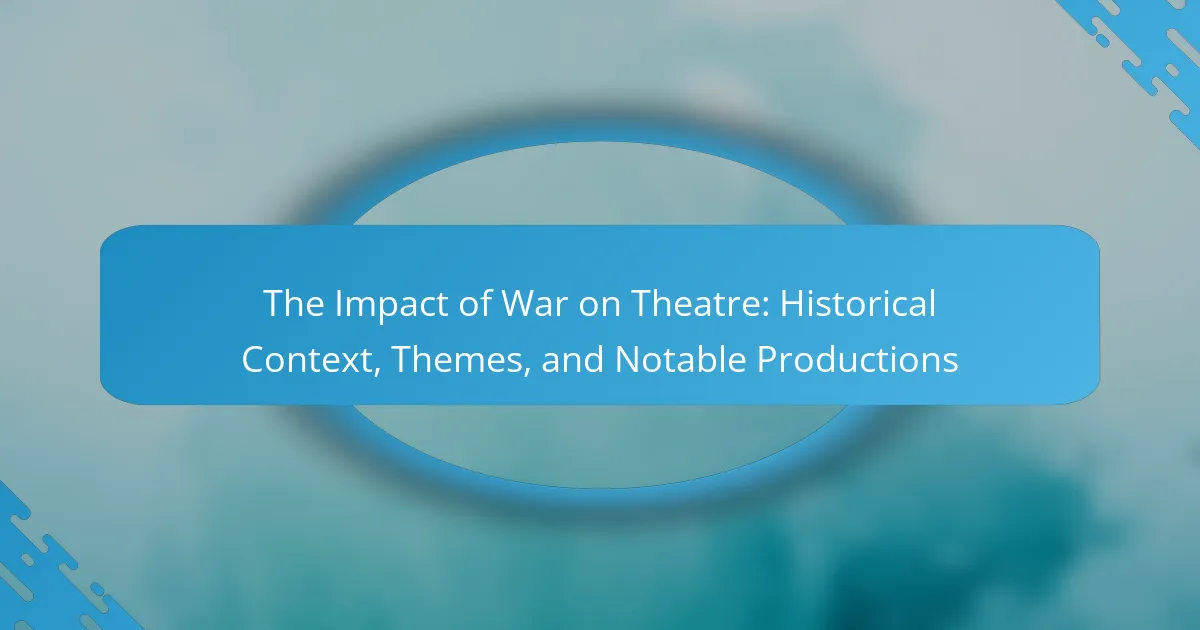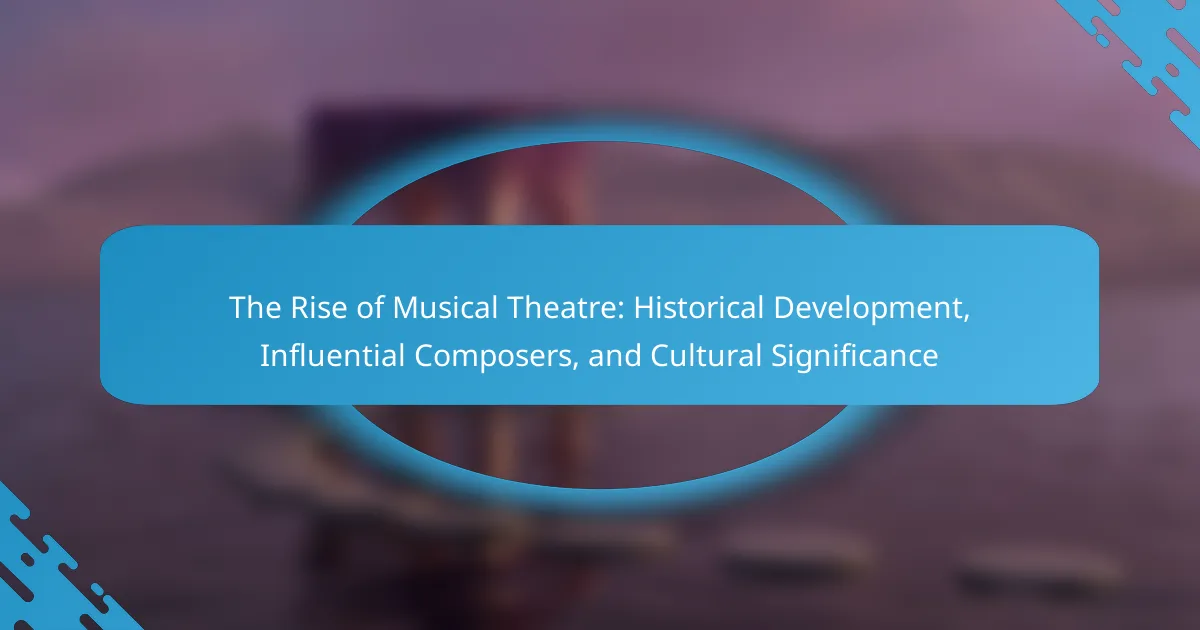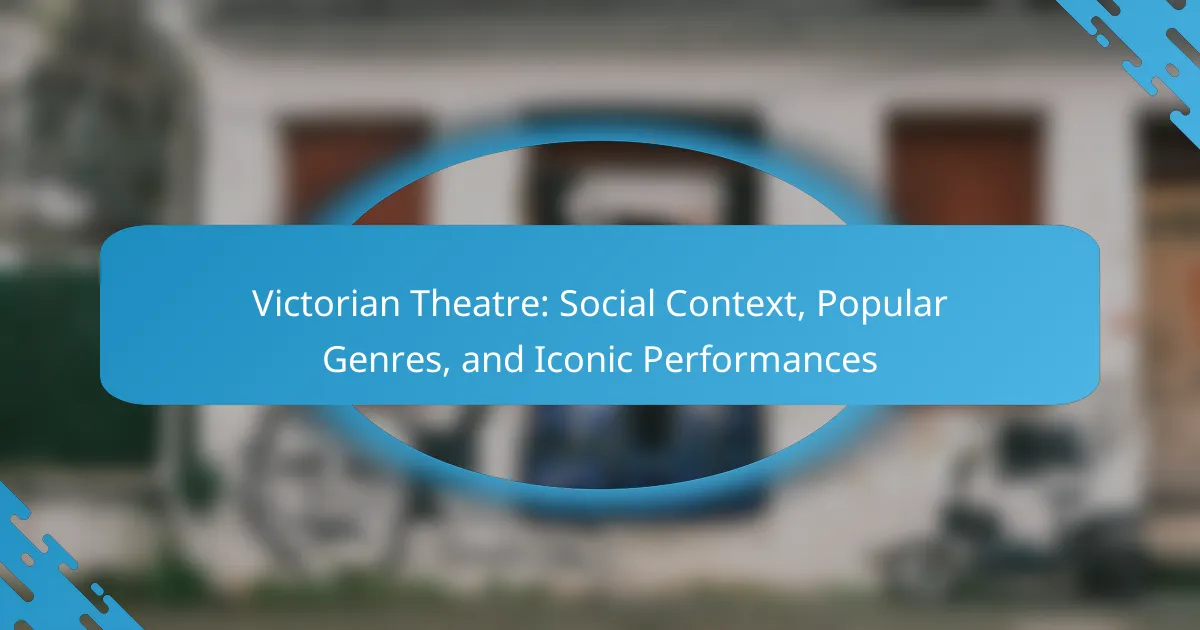Elizabethan Theatre encompasses the theatrical performances in England during Queen Elizabeth I’s reign from 1558 to 1603, a period renowned for the rise of English drama and iconic playwrights such as William Shakespeare and Christopher Marlowe. Notable venues like The Globe and The Rose hosted a variety of genres, including tragedies, comedies, and histories, appealing to a diverse audience across social classes. Key figures in this era include influential actors Richard Burbage, Edward Alleyn, and Will Kempe, whose performances significantly shaped the theatrical landscape. Additionally, innovative stage designs, such as the thrust stage and the use of trap doors, along with elaborate costumes and natural lighting, revolutionized the theatrical experience, laying the groundwork for modern theatre practices.

What is Elizabethan Theatre?
Elizabethan Theatre refers to the theatrical performances that occurred in England during the reign of Queen Elizabeth I from 1558 to 1603. This period is marked by the flourishing of English drama and the emergence of notable playwrights, including William Shakespeare and Christopher Marlowe. Theatres such as The Globe and The Rose became prominent venues for performances. Elizabethan Theatre featured a mix of genres, including tragedies, comedies, and histories. Performances were characterized by elaborate costumes and minimal staging. The audience included all social classes, reflecting the diverse appeal of the plays. The era significantly influenced the development of modern theatre practices and storytelling techniques.
How did Elizabethan Theatre emerge during its historical context?
Elizabethan Theatre emerged during a time of political stability and cultural flourishing in England. The reign of Queen Elizabeth I from 1558 to 1603 fostered an environment conducive to the arts. The dissolution of the monasteries and the rise of the merchant class created new opportunities for public entertainment. The construction of permanent theatres, such as The Theatre in 1576, provided dedicated spaces for performances. Playwrights like William Shakespeare and Christopher Marlowe contributed to the rich literary output of the period. The influence of classical literature and humanism shaped the themes and styles of the plays. Additionally, the patronage of the monarchy and nobility supported theatrical productions. These factors combined to establish Elizabethan Theatre as a significant cultural phenomenon in history.
What were the key influences on the development of Elizabethan Theatre?
The key influences on the development of Elizabethan Theatre include the Renaissance, classical literature, and the patronage of the monarchy. The Renaissance brought a renewed interest in art and culture, inspiring playwrights to explore new themes. Classical literature, especially works by ancient Greeks and Romans, provided foundational storytelling techniques. The patronage from Queen Elizabeth I allowed theatre to flourish, as she supported playwrights and actors. Additionally, the establishment of public theatres in London, such as The Globe, created accessible venues for performances. These factors collectively shaped the unique characteristics of Elizabethan Theatre.
How did societal changes impact the themes and styles of Elizabethan plays?
Societal changes significantly influenced the themes and styles of Elizabethan plays. The Renaissance period brought a renewed interest in humanism and classical literature. This shift led playwrights to explore complex characters and moral dilemmas. The rise of the middle class expanded audiences and encouraged diverse themes, such as ambition and power. Additionally, the Protestant Reformation altered religious contexts, prompting plays to address faith and morality. The influence of political events, such as the Spanish Armada, introduced themes of national identity and conflict. Overall, these societal changes enriched the narrative depth and stylistic variety of Elizabethan theatre.
What are the defining characteristics of Elizabethan Theatre?
Elizabethan Theatre is characterized by its use of elaborate staging, diverse genres, and a focus on human emotion. The theatres were open-air and often circular in design, allowing for natural light. Performances featured a mix of tragedy, comedy, and history, appealing to a wide audience. Notable playwrights like William Shakespeare and Christopher Marlowe contributed significantly to its repertoire. The use of language was rich and poetic, enhancing the dramatic experience. Actors were predominantly male, as women were not permitted on stage. Costumes were elaborate and indicated social status. The period saw the emergence of iconic venues like The Globe Theatre, which became central to theatrical performances.
What role did language and poetry play in Elizabethan plays?
Language and poetry were central to Elizabethan plays. They shaped the emotional depth and complexity of characters. The use of iambic pentameter created a rhythmic structure. This structure enhanced the memorability of lines. Poetic devices like metaphors and similes enriched the dialogue. They allowed for deeper exploration of themes and emotions. Shakespeare, a key figure, utilized language to convey intricate human experiences. His works demonstrate the power of language in engaging audiences. This emphasis on language and poetry distinguished Elizabethan theatre from earlier forms.
How did the structure of Elizabethan plays differ from earlier theatrical forms?
Elizabethan plays featured a five-act structure, differing from the three-act format common in earlier theatrical forms. This five-act division allowed for more complex character development and intricate plots. Additionally, Elizabethan plays often included subplots, enriching the narrative. Earlier forms typically focused on linear storytelling without such depth. The use of blank verse became prominent in Elizabethan theatre, enhancing the poetic quality of dialogue. Earlier plays often relied on prose, which lacked this lyrical element. Furthermore, Elizabethan plays incorporated a mix of genres, blending tragedy and comedy within a single work. This was less common in previous theatrical traditions, which maintained strict genre boundaries. The introduction of soliloquies provided insight into characters’ thoughts, a technique not widely used before. Overall, these structural innovations marked a significant evolution in theatrical storytelling.
What were some influential works of Elizabethan Theatre?
Some influential works of Elizabethan Theatre include “Hamlet,” “Macbeth,” and “A Midsummer Night’s Dream.” These plays were written by William Shakespeare, a central figure in this era. “Hamlet” explores themes of revenge and madness. “Macbeth” delves into ambition and guilt. “A Midsummer Night’s Dream” combines romance and fantasy. Other notable works include Christopher Marlowe’s “Doctor Faustus” and Thomas Kyd’s “The Spanish Tragedy.” These plays contributed significantly to the development of English drama. They introduced complex characters and intricate plots. The Elizabethan Theatre period was marked by innovation in storytelling and stagecraft.
Which playwrights were most prominent during the Elizabethan era?
William Shakespeare, Christopher Marlowe, and Ben Jonson were the most prominent playwrights during the Elizabethan era. William Shakespeare is widely regarded as the greatest playwright of all time. His works include classics like “Hamlet,” “Othello,” and “Romeo and Juliet.” Christopher Marlowe is known for his influential plays such as “Doctor Faustus” and “Tamburlaine.” Ben Jonson, a contemporary of Shakespeare, made significant contributions with works like “Volpone” and “The Alchemist.” These playwrights shaped the landscape of English drama and left a lasting legacy on literature. Their works are still performed and studied today, highlighting their enduring impact.
What themes and motifs are commonly found in these influential works?
Common themes in influential works of Elizabethan theatre include love, power, and betrayal. Love often drives the plot and character motivations. Power dynamics explore the rise and fall of rulers and their consequences. Betrayal highlights the fragility of trust among characters. Motifs such as mistaken identity and the supernatural frequently appear, adding complexity to the narratives. These elements reflect the societal issues and human experiences of the time. Works like “Hamlet” and “Romeo and Juliet” exemplify these themes through their intricate character relationships and moral dilemmas.

Who were the notable actors of Elizabethan Theatre?
Notable actors of Elizabethan Theatre include Richard Burbage, Edward Alleyn, and Will Kempe. Richard Burbage was the leading actor in Shakespeare’s plays. He was known for his roles in “Hamlet” and “Othello.” Edward Alleyn was famous for his performances in Christopher Marlowe’s works. He was a prominent actor and co-founder of the Fortune Theatre. Will Kempe was recognized for his comedic roles and was a member of Shakespeare’s company. These actors significantly influenced the development of theatre during the Elizabethan era. Their performances helped shape the theatrical landscape of the time.
What contributions did key actors make to Elizabethan Theatre?
Key actors significantly shaped Elizabethan Theatre through their performances and innovations. They brought emotional depth and complexity to characters, enhancing audience engagement. Notable actors like Richard Burbage pioneered the portrayal of tragic heroes, elevating the dramatic quality of plays. Actors often collaborated with playwrights, influencing script development and character arcs. The use of elaborate costumes and stage presence by actors added visual appeal to performances. Their ability to perform multiple roles showcased versatility and creativity. Additionally, actors contributed to the popularity of theatre, drawing larger audiences to venues like The Globe. Their impact on theatrical techniques and storytelling remains influential in modern theatre.
Who were the leading actors and what roles are they most remembered for?
Leading actors in Elizabethan theatre include Richard Burbage and Edward Alleyn. Richard Burbage is most remembered for his role as Hamlet. He was the first actor to portray many of Shakespeare’s most famous characters. Edward Alleyn is known for his powerful performances, particularly as Faustus in Marlowe’s “Doctor Faustus.” Both actors significantly shaped the theatrical landscape of their time. Their contributions helped elevate the status of actors in society. Burbage’s and Alleyn’s performances set standards for future generations of actors.
How did the performance styles of these actors shape audience perceptions?
The performance styles of actors in Elizabethan theatre significantly shaped audience perceptions by enhancing emotional engagement and character authenticity. Actors like Richard Burbage utilized physicality and vocal modulation to convey complex emotions. This approach allowed audiences to connect deeply with characters, fostering empathy and understanding. The use of soliloquies by actors created a direct line of communication with the audience. This technique made the audience privy to characters’ inner thoughts, altering their perceptions and judgments. Additionally, the incorporation of improvisation added spontaneity, making performances feel more genuine. The varied styles of actors contributed to a richer theatrical experience, influencing how audiences interpreted narratives and themes.
What was the significance of gender roles in Elizabethan acting?
Gender roles in Elizabethan acting were significant due to societal norms and theatrical practices. During this period, women were prohibited from performing on stage. Male actors played female roles, leading to a unique dynamic in performances. This practice highlighted the limitations and expectations placed on women in society. It also allowed male actors to explore femininity in their performances. The absence of female performers influenced the portrayal of women in plays. Additionally, it contributed to the development of complex male characters. Overall, gender roles shaped the theatrical landscape of Elizabethan theatre.
How did the absence of female actors influence the portrayal of women in plays?
The absence of female actors significantly influenced the portrayal of women in plays. Male actors portrayed female characters, leading to exaggerated and often stereotypical depictions. This practice resulted in a limited representation of women’s complexities and realities. The voices of women were largely absent from the narratives, impacting the authenticity of female roles. Historical records indicate that plays often emphasized physical appearance over character depth. For instance, the use of cross-dressing highlighted societal views on gender roles. Consequently, female characters were often reduced to mere plot devices. The absence of authentic female perspectives shaped the overall narrative structure in Elizabethan theatre.
What were the social implications of male actors playing female roles?
Male actors playing female roles in Elizabethan theatre reinforced gender norms and societal expectations. This practice limited women’s roles in public life and performance. It reflected the patriarchal structure of society, where men dominated both the stage and social spheres. The absence of female performers meant that male actors had to embody femininity, often exaggerating traits to convey female characters. This created a distorted perception of gender, emphasizing stereotypes. The portrayal of women by men also affected audience perceptions of femininity and masculinity. It contributed to the cultural narrative that women were less capable of performing publicly. Thus, the implications were significant, shaping societal views on gender roles during that era.

What stage innovations emerged during the Elizabethan era?
The Elizabethan era introduced several significant stage innovations. The use of the thrust stage allowed for better audience engagement. This design brought actors closer to the spectators. Additionally, the introduction of trap doors enhanced dramatic effects. These features allowed for special effects and surprises during performances. The use of painted backdrops created more immersive settings. Furthermore, the incorporation of elaborate costumes added to the visual appeal. Natural lighting was utilized effectively in outdoor theaters. These innovations collectively transformed theatrical performances in this period.
How did theatre architecture evolve in Elizabethan times?
Theatre architecture evolved significantly during Elizabethan times. The period saw the transition from simple, temporary structures to permanent, purpose-built theatres. The first permanent theatre, The Theatre, was constructed in 1576. It featured a circular design with an open roof, allowing natural light. The Globe Theatre, built in 1599, became iconic for its design. It had a thrust stage that extended into the audience, enhancing engagement. The use of multiple levels allowed for better viewing and varied stage action. Additionally, the incorporation of trap doors and special effects added to the spectacle. These architectural advancements reflected the growing popularity of theatre during this era.
What were the key features of Elizabethan theatres that enhanced performances?
Elizabethan theatres featured several key attributes that enhanced performances. The open-air structure allowed natural light to illuminate the stage. This design created an engaging atmosphere for audiences. The thrust stage extended into the audience, promoting closer interaction. The use of trap doors facilitated dramatic entrances and exits. Costumes were elaborate and visually striking, enhancing character portrayal. The presence of music and sound effects added emotional depth to the performances. Additionally, the audience’s active participation influenced the energy of the show. These features collectively contributed to a vibrant theatrical experience.
How did stage design and technology impact the storytelling in plays?
Stage design and technology significantly impacted storytelling in plays by enhancing visual narratives and audience engagement. Innovations such as trapdoors, flying machinery, and elaborate sets allowed for dynamic scene changes. These elements created a more immersive experience for the audience. The use of painted backdrops and perspective scenery added depth to the visual storytelling. Lighting technology, including torches and candles, set the mood and emphasized dramatic moments. Furthermore, sound effects and music complemented the emotional tone of the plays. Historical examples, such as Shakespeare’s Globe Theatre, showcased these advancements. The integration of these design elements transformed the storytelling landscape in Elizabethan theatre.
What innovations in performance techniques were introduced?
Innovations in performance techniques during Elizabethan Theatre included the use of heightened language and soliloquies. These techniques allowed for deeper character exploration and emotional expression. The introduction of the thrust stage enabled closer interaction between actors and the audience. This design created a more immersive experience. Additionally, the use of elaborate costumes enhanced visual storytelling. Actors employed physicality and movement to convey emotions effectively. The integration of music and sound effects added another layer to performances. These innovations significantly transformed theatrical presentations during the Elizabethan era.
How did the use of props and costumes enhance the theatrical experience?
The use of props and costumes significantly enhanced the theatrical experience by providing visual context and character depth. Props helped to establish the setting and time period of the play. For instance, a sword could signify conflict and drama, while a goblet might indicate a royal banquet. Costumes conveyed social status and personality traits of characters. They allowed audiences to quickly understand roles and relationships within the story. Historical accuracy in costumes also contributed to the authenticity of the performance. Additionally, vibrant colors and intricate designs captivated the audience’s attention. This visual stimulation made the experience more engaging and immersive. Overall, props and costumes were essential tools in storytelling during the Elizabethan era.
What role did music and sound effects play in Elizabethan performances?
Music and sound effects played a crucial role in Elizabethan performances. They enhanced the emotional impact of the plays. Music was used to signify changes in mood or scene. It also helped to establish the setting and time period. Sound effects added realism to the performance. For instance, thunder sounds indicated storms or conflict. Specific instruments were chosen for their emotional resonance. The use of music and sound effects contributed significantly to audience engagement. Historical records indicate that music was integral to many popular plays of the time.
What lessons can modern theatre learn from Elizabethan Theatre?
Modern theatre can learn the importance of audience engagement from Elizabethan Theatre. Elizabethan productions often broke the fourth wall and interacted directly with the audience. This approach created a dynamic atmosphere and heightened emotional connection. Additionally, the use of diverse genres in Elizabethan plays showcased versatility. Modern theatre can incorporate a mix of tragedy, comedy, and romance to appeal to varied audiences. The emphasis on strong character development is another lesson. Elizabethan playwrights crafted complex characters that resonated with audiences. Lastly, the innovative use of stage technology, such as trap doors and elaborate sets, can inspire modern productions to enhance visual storytelling. These elements contributed to the lasting impact of Elizabethan Theatre.
How can contemporary productions incorporate elements of Elizabethan stage innovations?
Contemporary productions can incorporate elements of Elizabethan stage innovations by utilizing thrust stages. Thrust stages extend into the audience, enhancing engagement. This format mirrors the Globe Theatre’s original design, which facilitated interaction between actors and viewers. Additionally, contemporary productions can adopt minimalistic set designs. Elizabethan theatre often relied on suggestive staging rather than elaborate sets. This approach allows for greater flexibility and creativity in storytelling.
Moreover, incorporating the use of live music and sound effects can enhance the theatrical experience. Elizabethan plays frequently included music to set the tone and mood. Contemporary productions can also embrace the use of soliloquies. This technique provides insight into characters’ thoughts, a hallmark of Elizabethan drama. Lastly, employing a diverse cast can reflect the inclusive spirit of modern interpretations, while still honoring the traditional text and themes.
What best practices from Elizabethan Theatre can enhance modern storytelling?
Elizabethan Theatre best practices that can enhance modern storytelling include the use of vivid character development, engaging dialogue, and thematic depth. Theatrical performances during this period focused on strong, relatable characters. These characters often faced moral dilemmas, making them compelling to audiences.
Additionally, Elizabethan playwrights utilized dialogue that was both poetic and accessible. This approach captured the audience’s attention and conveyed emotions effectively. Thematic exploration, such as the human condition and societal issues, also played a crucial role.
Historical examples include Shakespeare’s works, which combine these elements to create enduring narratives. His characters, like Hamlet and Macbeth, exhibit complex motivations and conflicts. The use of soliloquies provides insight into their inner thoughts, enhancing audience connection.
Incorporating these practices into modern storytelling can lead to richer narratives and deeper audience engagement.
Elizabethan Theatre refers to the theatrical performances in England during Queen Elizabeth I’s reign from 1558 to 1603, characterized by the emergence of influential playwrights like William Shakespeare and Christopher Marlowe. The article covers the historical context of Elizabethan Theatre, its defining characteristics, and key influences, including the Renaissance and classical literature. It discusses notable works, prominent actors, and the significant stage innovations that shaped performances, as well as the impact of societal changes on themes and storytelling techniques. Furthermore, it highlights the lessons modern theatre can learn from this era’s practices and innovations.


